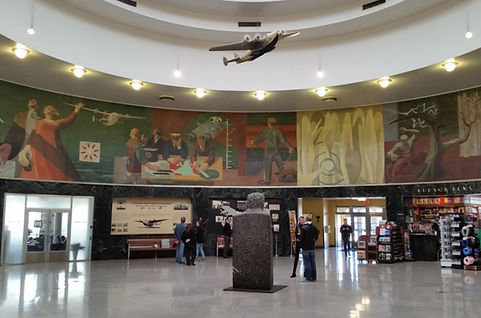Charlotte Park and James Brooks, photo by Maurice Berezov
CHARLOTTE PARK (1918-2010) and JAMES BROOKS (1906-1992)
Charlotte Park was born in Concord, Massachusetts and graduated from the Yale School of Art in 1939. In 2010, the New York Times art critic, Roberta Smith, called Park "a natural painter and a gifted colorist." Her early works were muscular abstractions, often in a monochrome palette. During WWII, Park worked for the Office of Strategic Services in Washington, D.C. and it was there that she and James Brooks met. Together, the couple moved to New York City in 1945 where Park studied privately with the Australian artist Wallace Harrison. Her first solo exhibition was in 1957 at Tanager Gallery.
Invigorated by the rise of Abstract Expressionism, the couple became close friends with many of the movement's pioneers including Lee Krasner and Jackson Pollock, Franz Kline, and Willem and Elaine de Kooning. In 1948, like so many artists of the New York School, the couple found a home and studio on Long Island's east end. Living in the bucolic landscape would have a profound effect on Park's work. By the mid-1950s, she began to embrace color and developed a style in which lyricism was conjoined with dramatic form and bold compositional elements. She explored collage, creating complex, layered works. Later, her compositions became more minimal, owed in part to her interest in neo-plasticism and the art of Piet Mondrian. She became a naturalist, maintaining journals that contain assiduous notes on birds, plant species, and aspects of the natural world. She lived on Neck Path in Springs until her death in 2010.
James Brooks, one of the pioneers of American abstract expressionist painting, was born in St. Louis, Missouri, in 1906. From 1923-1925 he majored in art at Southern Methodist University, moving to New York in 1926 where he studied at the Grand Central Art School and the Art Students League. From 1938-1942, under the auspices of the New York City WPA Federal Part Project, he painted murals in the Woodside Public Library in Queens and the Marine Air Terminal at La Guardia Airport - the largest WPA mural in the nation and one of the last to be completed under that program.
Brooks served in the United States Army from 1942-1945. He finished his military service at the Office of Strategic Services in Washington, DC, where he met his future wife, Charlotte Park. After the war, they moved to New York City. When Jackson Pollock and Lee Krasner, Brooks' friends from the WPA days, were moving out of their apartment-studio on East 8th Street, the couple took over their lease. They were married in 1947. They often visited Pollock and Krasner in East Hampton, and in 1948 they leased property in Montauk, eventually relocating to Springs. A leading member of the New York School, in 1951 Brooks was included in the historic "Ninth Street Exhibition." In 1956, his work was part of "Twelve Americans," at the Museum of Modern Art as well as MoMA's exhibition, "New American Painting," which traveled though Europe. He lived and worked in Springs until his death in 1992.
In New York, both Charlotte and James enjoyed the kinship and visibility of the avant-garde, many of whom summered in the Hamptons. Life in Springs offered a different type of camaraderie, and the couple thrived there among the working artists and locals of the community. They were diligent and hard working and enjoyed their private life at home and in the studio.
As their mutual practices advanced, both artists embraced new directions. Park discovered radiant color, perhaps a result of living in Springs. Brooks began to simplify his compositions while still favoring bold, dramatic form. They both exhibited widely, but the art world was largely unforgiving to female artists, and Park's career suffered while Brooks was ascendant. He would have five retrospectives in his lifetime, and his work is represented by some of the finest art institutions in the country.
















